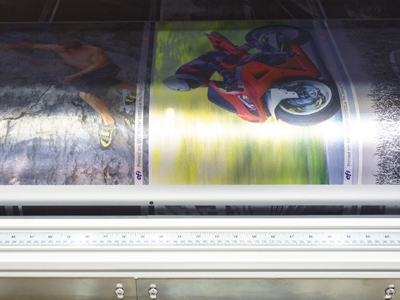EFI showed AquaEndure at drupa
Next generation inkjet inks promise to combine the best of water-based and UV curing technologies with none of the drawbacks, Barney Cox reports.
As digital printing continues to make inroads into new applications, the demands placed on the technology evolve. A lot of the current uses for digital are for promotional and informational purposes, to which the consumer will have limited contact or exposure. The newer applications, in particular packaging, but also interior décor, are in more intimate contact with the customer. That means the materials have to be both pleasant and safe to handle. For packaging, especially for food use, the materials used have to meet even tighter restrictions to ensure that potentially dangerous chemicals cannot contaminate the products within the packaging.
Safe and sound
There are also broader legislative issues surrounding the use of potentially hazardous materials, which are becoming stricter, such as REACH. Ink vendors watching the evolution of such legislation are mindful that those changes may restrict the use of some materials, making reformulation necessary. In some cases the changes mean more than just reformulating an existing product, and so they are working on completely new classes of ink that will meet both the new legislative and market requirements.
Water-based UV (WUV) is a recent development that has been embraced by a number of equipment and ink vendors to address these concerns. Moving to water as the base material offers a number of advantages, including greatly reduced amounts of the core components of UV ink, the monomers that form the final film and the photoinitiators (PI) that enable the energy supplied by UV radiation to cure, or polymerise, those monomers. It also enables a wider range of photoinitiators and monomers to be used in the formulations, meaning that current ones that would cause problems in new applications and under new legislation can be avoided.
While other water-based technologies such as Latex (really a thermosetting resin) offer some of the advantages, their need for high amounts of heat introduce their own such increasing energy consumption and limiting the range of materials that can be printed.
Leaving a bad smell
There is no getting away from the fact that some UV cured ink formulations have a distinctive smell, which is problematic for a number of applications. Strong odours are not just unpleasant but may taint products too in the case of packaging. In other emerging markets such as décor, whether it is in retail, hospitality, healthcare or domestic settings, strong odours could prove extremely detrimental. Possibly to the point where leaving a bad smell renders the benefits digital printing offers to add value void.
Smell is not the only sense that WUV inks impact. It may seem odd to talk about the appearance of ink, after all it is fundamental to any printed image, however, different inks do look different. One of the most significant influences of that is the ink film thickness. Most UV inks have a noticeable relief or thickness, and often as a result a different level of gloss to the underlying substrate. While advances in inks and especially curing have improved the gloss differential, the thickness can still be an issue, especially if any analogue process being substituted, such as litho, has a very thin ink film that is not so noticeable. WUV inks produce a much thinner ink film than other UV technologies.
Who, what, when
First into the market was Durst, which showed its concept Rho 250WT at Fespa 2015 and launched the product at Fespa 2016. The Rho 250 WT is a 2.5m scanning system suitable for corrugated POS. At drupa Durst showed its single-pass corrugated packaging machine the SPC 130, which is based on its water technology. Sun Chemical also announced its Aquacure technology at Fespa 2015, and showed technology demonstrations at last year’s LabelExpo and Fespa earlier this year. While the technology has won an award for innovation from The Stationers, to date there have been no details of the commercialisation of the technology by Sun or any partners. Fujifilm originally announced a variant of its B2 sheetfed inkjet Jet Press that was to use a water-based UV technology at drupa 2012. While that has not made it to market, the firm is still developing the technology, although it has yet to confirm any plans for the commercialisation of it.
Ink technology comparison

*Based on a table produced by EFI
EFI announced its version of the technology AquaEndure at drupa 2016 and showed the inks as a technology demonstration using a roll to roll printer. The firm plans to launch its first product based on AquaEndure inks in early 2017, which will be a roll to roll printer for the wallcoverings market. It has also said that in due course the ink will be extended to roll to roll display graphics and wraps, packaging and rigid materials. Although the first version of the EFI Nozomi single-pass press platform, the C18000 for corrugated packaging, uses LED UV inks, AquaEndure will also be used on some subsequent Nozomi machines.
It is early days for WUV technology with very few installations to provide real world feedback. However, with so many significant vendors committed to the technology, and its undoubted benefits for several applications, it is only a matter of time before there will be. If you are involved in, or are considering entering, any of the markets that WUV is relevant to, understanding its potential is important to ensure you make the correct technology decision.





